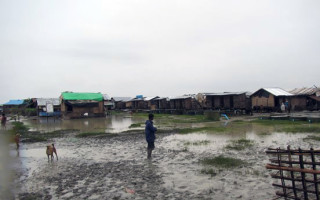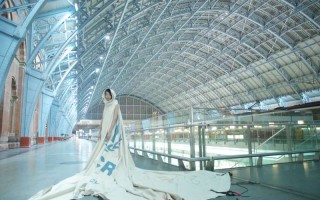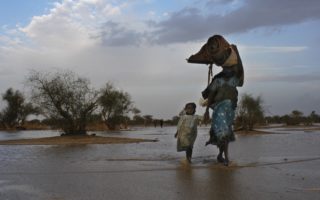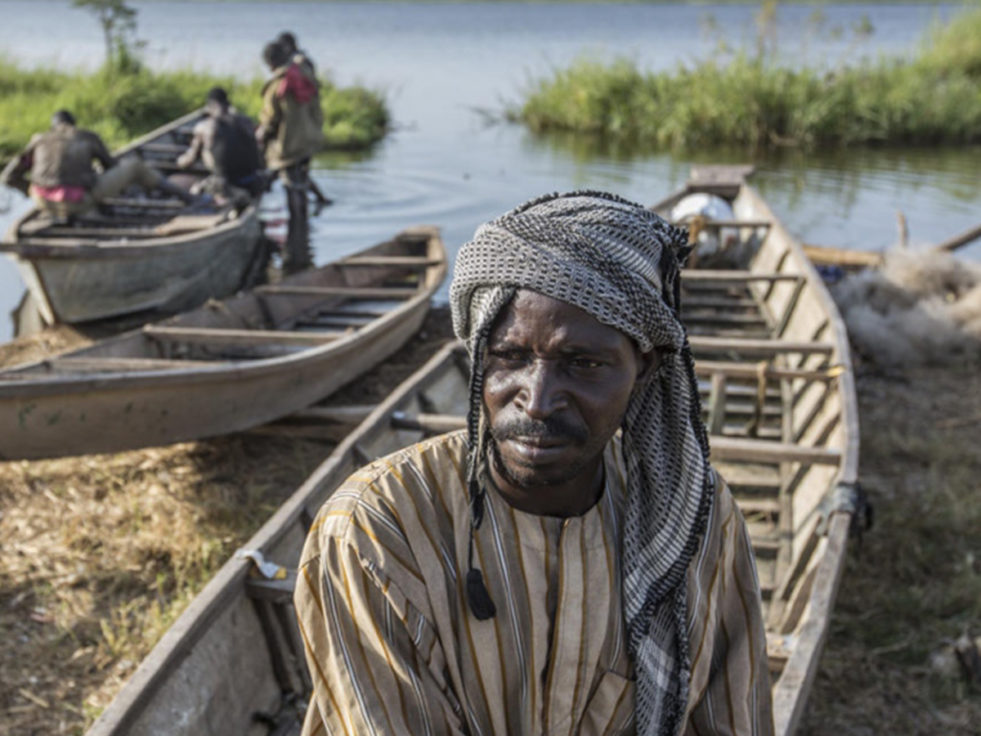
Nigerian refugee, Hawali Oumar, 43, fishes Lake Chad for up to ten days at a time, while his family remain at a camp a few miles away. Hawali’s father was killed by Boko Haram in his village in Nigeria, prompting him to flee to Chad with his family of 10. © UNHCR/Oualid Khelifi
How conflict and climate change form a toxic combination that drives people from their homes.
They murdered his father, torched his neighbourhood and sent him running for his life. Rounding up as many family members as he could find, Hawali Oumar fled his hometown of Baga, in north-eastern Nigeria, to escape the killers of Boko Haram. Together, they made the journey over the border to the Chadian side of Lake Chad.
Even away from the gunfire, Hawali, a 46-year-old fisherman, found that his problems were not over. With help from UNHCR, the UN Refugee Agency, in the form of a boat, nets and other gear, he has managed to sustain himself and his extended family by plying his trade in his new community. But the once mighty Lake Chad, a source of water and livelihoods for millions of people, has shrunk by 90 per cent since the 1960s. Invasive plants cover half of what is left, making it harder for boats to gain access to the lake. Because of climate change, population growth and unregulated irrigation, the surrounding area suffers from desertification, deforestation and drought.
As a result, life for the communities around Lake Chad gets tougher every year. Violence in the region has driven millions of people from their homes in Chad, Cameroon, Nigeria and Niger. And the swelling population of the displaced must jostle for a meagre share of the area’s dwindling resources.
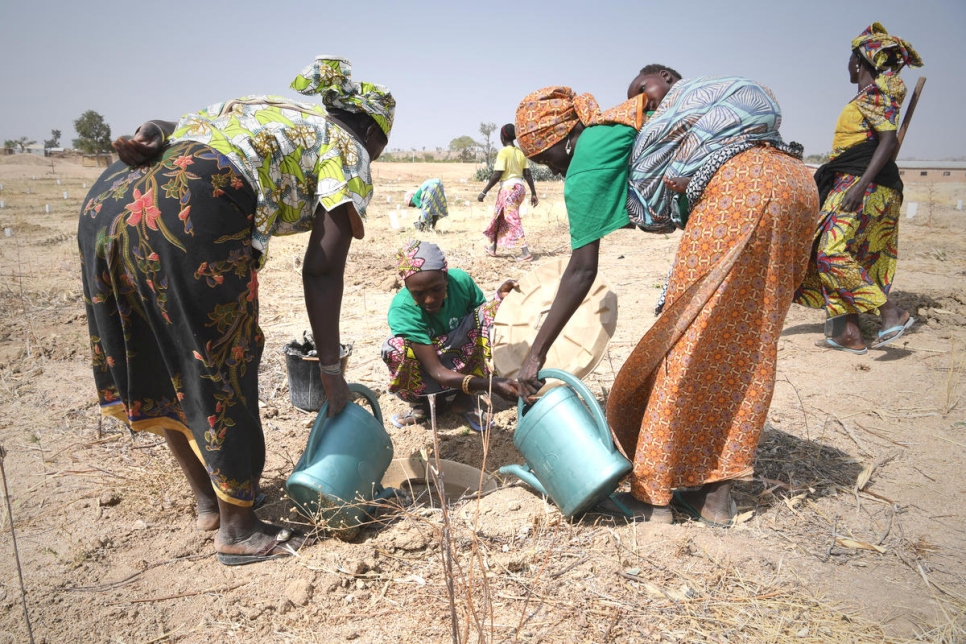
As the region of Minawao faces critical deforestation due to the global warming and the human activity of 56,000 Nigerian refugees, the UNHCR and its partners Land Life Company and LWF started a reforestation project. In the next two years, they expect to plant -with the refugees- 20.000 trees in and around the site, using the “cocoon” technology to allow the plants to survive in an hostile environment. © UNHCR/Xavier Bourgois
Hawali’s story is only one illustration of how the world’s displaced are on the front line of climate change. Of the 20.4 million refugees under UNHCR’s mandate at the end of 2018, a third were located in the world’s least developed countries, which are often highly vulnerable to the adverse effects of climate change, or which suffer from a scarcity of resources and infrastructure. The impact of natural disasters and the more gradual effects of climate change — such as the receding waters of Lake Chad, rising sea levels for coastal communities, longer and harsher droughts, or the creep of desertification — can create new displaced populations and pose challenges for existing ones.
With desertification threatening the area around Minawao refugee camp, in northern Cameroon, UNHCR, Land Life Company and the Lutheran World Foundation teamed up to restore over 100 hectares of land in the area.
Why environmental issues matter to refugees and UNHCR
Climate change and natural disasters can add to and worsen the threats that force people to flee across international borders. The interplay between climate, conflict, poverty and persecution greatly increases the complexity of refugee emergencies. “Forced displacement across borders can stem from the interaction between climate change and disasters with conflict and violence, or it can arise from natural or man-made disasters alone. Either situation can trigger international protection needs,” said Filippo Grandi, UN High Commissioner for Refugees.
The interplay between climate, conflict, poverty and persecution greatly increases the complexity of refugee emergencies.
Take, for instance, the worsening droughts in Somalia, which along with Al-Shabab-related violence are driving thousands of people to flee within the country or trek to Ethiopia. Shalle Hassan Abdirahman, a Somali refugee who fled to Ethiopia, survived a spell as a captive of Al-Shabab before he managed to escape. Once free, however, he decided he had no choice but to leave. Al-Shabab had also been forcing him and other farmers to pay a “tax” on their earnings even though drought was already curtailing their livelihoods and leaving them with less to eat. Years ago, the nearby river had overflowed when the rains arrived, nourishing the land and enabling crops to grow. “Now the river has no water and the sky has no rain,” Shalle Hassan said. The river and the weather are in the hands of Allah, he added, but the threats and extortion from Al-Shabab made life intolerable. “No human being will remain there — there is drought in the land and no rain. And the people left behind are afraid that with Al-Shabab they will get killed.”
Existing refugee populations can also fall victim to climate change or natural disasters and hazards. When Tropical Cyclone Idai hit Mozambique, Zimbabwe and Malawi in March 2019, for instance, UNHCR relocated refugee families to safer shelters and provided them with tents, plastic sheeting, sanitation equipment and clean water. Similarly, UNHCR has been helping Rohingya refugees in southern Bangladesh to mitigate the effects of monsoon storms, flooding and landslides.
But forced displacement itself can be a source of tension and potential conflict if there is added competition for natural resources, land rights, food and water — problems amplified by the adverse effects of climate change. Such issues can worsen relations between refugees and their non-refugee neighbours, or even help to create new refugee emergencies by themselves.
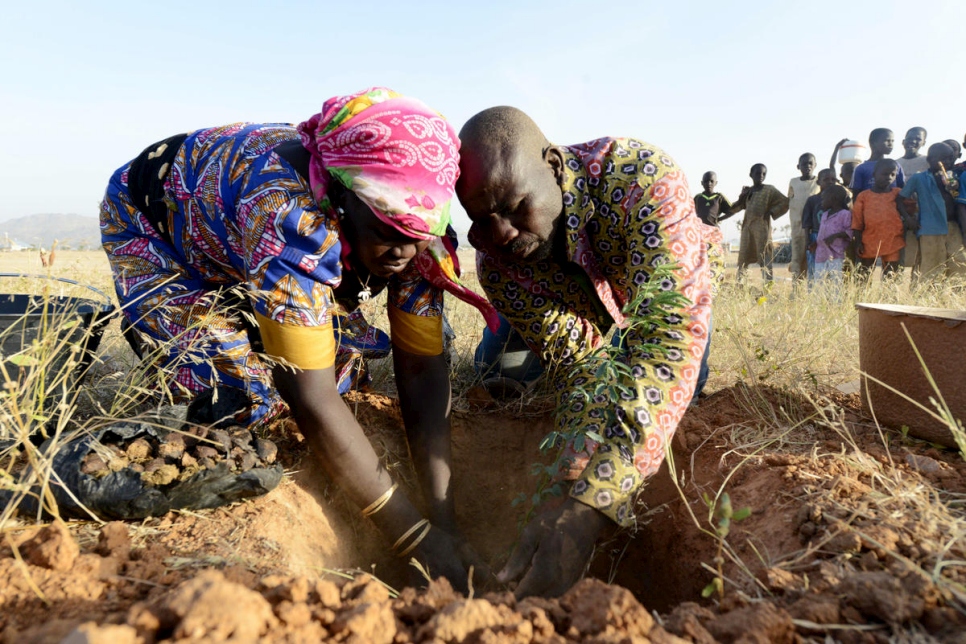
As the region of Minawao faces critical deforestation due to the global warming and the human activity of 58,000 Nigerian refugees, the UNHCR and its partners Land Life Company and LWF started a reforestation project. In the next two years, they expect to plant -with the refugees- 20.000 trees in and around the site, using the “cocoon” technology to allow the plants to survive in an hostile environment. © UNHCR/Xavier Bourgois
“Climate factors drive people out of their homes but large-scale refugee movements — whether or not climate-induced — have themselves in turn an environmental impact, and refugees are frequently located in climate hotspots,” said Grandi. “At UNHCR, we have worked for years to reduce the environmental impact of refugee crises through renewable energy options, reforestation activities, and access to clean fuels and technology for cooking. We have now launched a revitalized energy strategy and are improving our tools to address these challenges.”
What does the law say about climate change and refugees?
Most climate change displacement is internal, not cross-border. Even when people are displaced solely by the effects of climate-related disasters and natural hazards and cross international borders, they do not generally become refugees under the definition of the 1951 Refugee Convention: someone who has crossed an international border “owing to well-founded fear of being persecuted for reasons of race, religion, nationality, membership of a particular social group or political opinion”. Technically speaking, therefore, the term “climate refugee” is something of a misnomer, as it has no basis in international law and does not accurately reflect the complex ways in which climate and human mobility interact. But, as the UNHCR chief has pointed out, “the image it conveys — of people driven from their homes as an outcome of the climate emergency — has rightly captured public attention.”
As illustrated above, climate change and disasters frequently exacerbate the conditions that create forced displacement across borders, providing extra impetus to flee. In particular, where people are displaced as a result of disasters or climate-related factors that are interlinked with conflict or persecution, the 1951 Convention is likely to apply. Some people displaced across borders in the context of climate change or natural disasters may fall within the definition of “refugee” under regional instruments if and when flight is a result of a serious disturbance to public order. Those who do not may still need international protection, such as temporary protection and stay arrangements, or other forms of residency in the country to which they fled.
In sum, international law can have a role to play in a wide range of situations involving climate change and forced displacement. With more and more people expected to be displaced by environmental factors in the coming years, UNHCR is heavily involved in policymaking and in shaping and adapting legal frameworks in this area. Given its expertise in international protection and decades of experience of displacement emergencies, the agency is ready to make its resources available whenever its help is needed.
“Where disaster-related displacement occurs, a strong operational response, guided by protection considerations, is often needed. UNHCR will continue to work in inter-agency contexts to support governments, building on our strong expertise in emergency response,” said Grandi. He added that the Global Compact on Refugees, the blueprint for how states should be sharing the responsibility for refugees, called for the inclusion of refugees in disaster risk reduction strategies.
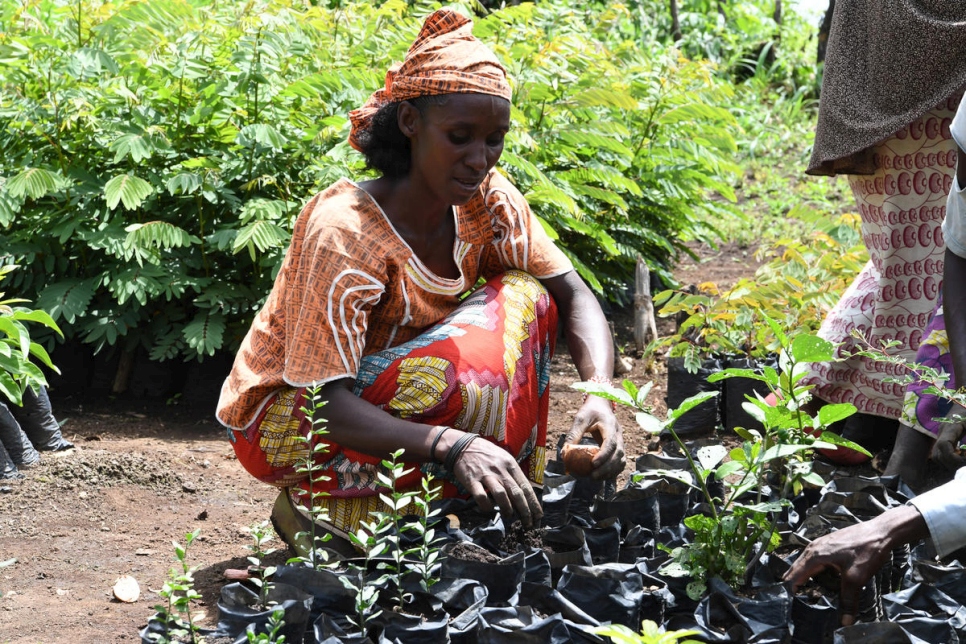
A woman tends to saplings in a tree nursery at Borgop refugee site, home to 18,000 people fleeing violence in Central African Republic. With humanitarian aid running low, UNHCR is urging the international community to increase funding for the CAR situation which (as of June) stands at just $12m of the $179m needed for 2018. © UNHCR/Xavier Bourgois
How UNHCR is helping refugees confront climate-related challenges
Aside from reducing greenhouse gas emissions and improving the environment around them, green initiatives are also helping refugees improve their resilience and well-being and are making their communities healthier and more sustainable.
A programme to distribute liquefied petroleum gas to Rohingya refugees in Bangladesh reached over 100,000 households by March 2019, including host community families, providing clean, reliable energy for cooking.
Azraq camp in Jordan became the world’s first refugee camp powered by renewable energy in 2017. Supported by the IKEA Foundation, this initiative provides affordable and sustainable electricity to 40,000 Syrian refugees.
A Nigerian refugee mother plants seeds in a nursery at Minawao refugee camp in Cameroon, as part of a project to reverse deforestation and desertification caused by a surge in population numbers in the area.
In Cairo, Egypt, UNHCR has supported efforts to clean up a busy stretch of the Nile by providing equipment and mobilizing volunteers from different refugee communities to haul out tonnes of plastic waste.
In northern Uganda, UNHCR is supporting a reforestation effort to replenish trees cut down for shelters and cooking fires — activities that were creating tension between refugees and local communities over resources.
In a camp hosting Sahrawi refugees near the town of Tindouf, in south-west Algeria, plastic bottles filled with sand are used to make weather-resistant, eco-friendly homes that can weather sandstorms and flooding.
Building a sustainable, climate-friendly legacy
After Typhoon Haiyan destroyed their home in the Philippines in late 2013, Algina Lacaba and her family relied on UNHCR and its partner UPS for a tent, kitchen equipment, mats and a solar lamp. Haiyan displaced more than 4 million people, killing thousands of others and obliterating entire communities. UNHCR enabled the progressive return of those whose homes had been swept away, working to strengthen the government’s capacity to provide basic services and upholding the right of displaced people to return voluntarily.
Once the super storm had passed, Algina’s husband Joel — who nearly drowned when he was swept away by floodwaters — joined local workers in building new, sturdier housing well above sea level. Making sure homes are equipped to face future climate-related threats is central to facilitating safe and sustainable returns.
UNHCR also supports planned relocation, which seeks to move people out of harm’s way when hazards such rises in sea levels threaten to render certain areas uninhabitable. With Georgetown University and other partners, the agency has developed guidance on the planned relocation of at-risk populations to protect them from disasters and the impact of climate change while respecting their human rights. UNHCR recently took part in an exercise led by the governments of Costa Rica and Panama to simulate a disaster and deal in real time with the “virtual fallout” — following up by issuing guidelines for the kind of protections displaced people in such a scenario might need.
Finally, the agency does not believe it can build sustainability and resilience by parachuting in clean technologies and imposing them from on high. UNHCR will continue to advocate for the empowerment of refugees and host communities through their full participation in the planning and implementation of energy programmes, knowledge transfer and capacity-building in technical and business skills, as well as support for bottom-up innovation to create locally appropriate interventions.
What about the agency’s own environmental footprint?
An organization with 17,000 staff working in more than 130 countries clearly has an operational “footprint” with an environmental impact. But we also have the ability and the opportunity to make changes at significant scale. As part of our policy of “Greening the Blue”, UNHCR is working to reduce plastic and paper waste, conserve water and energy, cut down on e-waste by favouring sustainable suppliers and recycling electronic goods, phase out our use of fossil fuels, and establish a fund for the internal use of green energy and sustainability.
UNHCR, the UN Refugee Agency, is a global organization dedicated to saving lives, protecting rights and building a better future for refugees, forcibly displaced communities and stateless people.
Originally published on UNHCR on 15 October 2019



